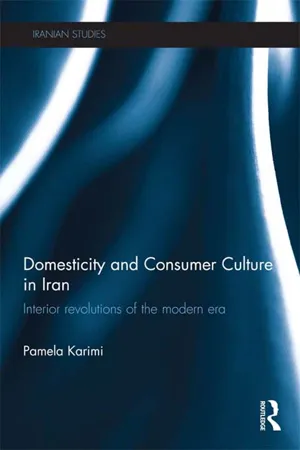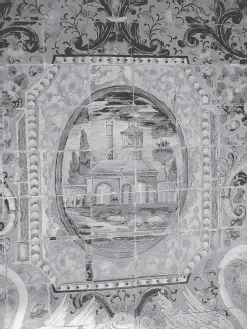![]()
1 The hovel, the harem, and the hybrid furnishing
Introduction
Long before the Pahlavi dynasty (1925–79) sought to improve the condition of Iranian domesticity by commissioning foreign and local architects and by initiating large-scale housing projects for the emerging working class, Iranians had been introduced to conceptions of modern Western domesticity through the country's political and commercial expansion under the Qajar dynasty (1796–1925). The importation of Western ideas and commodities accelerated under the lengthy reign of Nasir al-Din Shah (1848–96), during which many European diplomats, soldiers, technicians, and missionaries visited or settled in Iran. Nasir al-Din Shah's role was significant. He introduced telegraph and postal services, had new roads laid, initiated the first school offering education along Western lines, launched Iran's first newspaper, and gave impetus to major urban building projects.1 By the 1860s, the Shah had expanded old Tehran through the destruction of most of its worst-congested areas and their replacement by large squares and boulevards that were lit at night, a first.2 New residential suburbs were implemented north of Tehran, and the Shah's palace of Gulistān—founded in 1759—saw new construction within the complex between 1867 and 1892.3
While he was a ruler who was bound by the norms and practices of ancient Persian royal kinship, Nasir al-Din Shah simultaneously fostered the hope of modernizing Iran, not only by adopting Western artillery and hard science but also through importing European luxury goods, fabrics, furniture, china, and silverware.4 Like his great-grandfather, Fath Ali Shah (reigned 1797–1834), Nasir al-Din had a particular interest in promoting courtly arts, domestic life, royal feasts, and in spending time with the women of his harem. 5
Between 1873 and 1878, Nasir al-Din Shah made two trips to Europe. His travel diaries are filled with remarks about the architectural glamour of urban centers in Russia, France, England, and Austria.6 Upon his return, Nasir al-Din Shah did his best to implement European models of design by supervising the construction of new buildings at Gulistān Palace. The popular newspaper Sharaf (Honor) continuously showcased these new additions to the palace and emphasized the quality of furnishings used in them. Often referred to as asāshā-ya nafīs (fine furniture), basāthāy-a girānbahā (expensive gadgets), and mublhāy-a badī’ (modern chairs), the newspaper informed the readers of the high caliber of these interior contents.7 In 1892, Nasir al-Din Shah granted a 30-year concession to a Belgian group for manufacturing of glass, pottery, paper, and candles.8 Conversely, the European appetite for Persian artefacts, most notably carpets, led to a growth in the production of traditional-style rugs as substitutes for rare antiques.9 Between 1860 and 1910 the number of Persian carpet weavers rose from 1000 to 65,000 and, by 1930, the Persian carpet was the second main foreign currency earner, after oil.10 While tradition was fully safeguarded on the floors of Iranian homes, other furnishings were of eclectic styles that included old Persian, European, and even East Asian (chinoiserie).
Appropriation and aesthetics of everyday life in aristocratic settings
The designers of late-Qajar era were exceedingly capable of adapting and synthesizing a variety of local and foreign sources. Just as lithographic books and newspapers had started to implement Western-style floral vignettes and stylized page embellishments, the interior and exterior walls of residences also included Persian geometrical patterns and arabesque strapwork intertwined with Victorian rose garlands and naturalistic European landscape vignettes.11 Of European origin were spectacular mirrorworks (aynah karī) and figural stucco carvings (gach karī).12 Additionally, striking Western modes of representation were applied to narrative-based cuerda seca and underglazed tiles. Besides being a favored mode of decoration in Iran, Persian ceramics were in demand from the European market. A treatise prepared by Ali Muhammad Isfahani (active 1870s–1888) and compiled by John Fargues, under the title On the Manufacture of Modern Kashi Earthenware Tiles and Vases,13 paid tribute to the renewed interest in the traditional aesthetic techniques and old luster tilework already resurfacing in Persian ceramics. These techniques, developed much earlier, soared to heights of chromatic intensity during the reign of Nasir al-Din Shah, when an unprecedented naturalism was achieved through navy blue, soft greens, pinks, and chrome yellow pigments, and by introducing black shading. These polychrome tileworks represented meticulous naturalistic scenes, including Iranian and European subjects.14 The dado-lined entrance hall to the dīvānkhānah (governmental seat) was adorned with images of Nasir al-Din Shah surveying his troops or receiving guests; exterior walls meanwhile sported scenes of industrial European cities—often with the factory towers in the backdrop (see figure 1.1).15 Some representations seem to have been copied from actual photographs that had entered the Qajar court, as a result of Nasir al-Din Shah's fascination with yet another European import, the art and science of photography.16
Meanwhile, objects in lacquer and enamel, especially those distinguished by a mixture of old and new decorative patterns, became increasingly sought after. Chests, jewelry boxes, armoires, tables, cupboards, and mirror frames were adorned with the old arabesque motifs and the popular rose-and-nightingale (gul-u-bul-bul) theme as well as European-inspired realistic representations.17
Figure 1.1 Tilework, Gulistān palace. Photograph by the author, 2006
The Qajar approach to older styles was indeed a progressive appropriation of the art of previous dynasties; it was certainly more than just copying as a means to apprenticeship. The references to the style of the past,18 was accomplished through the selective use of particular events and legendary figures that received overwhelming attention, while others were entirely neglected. Similarly, borrowing from European themes was a conscious appropriation rather than a mark of surrender to European influences.
In contrast to the Egyptian and Ottoman open-door policy to Western trends, Iran's reaction was circumspect, if curious.19 Despite his mixed feelings about European involvement in the affairs of his country, Nasir al-Din Shah was aware of the advantages of technology, education, and healthcare. However, European colonialist attitudes—seen first and foremost in the proposed 1872 monopoly concession offered to Britain's Baron Julius de Reuter for railroad construction and the development of Iran's natural resources, mines, banking, and industrial potentials, which was withdrawn in 1873—also alerted him to the danger of opening the country wholesale to Western culture and policy.20 Perhaps it was due to these antithetical mindsets that the Persians did not candidly acknowledge their profound fascination with Western imports and influence. In his 1885 travelogue, Le Caucase et la Perse (The Caucasus and Persia), the Belgian consultant Ernest Orsolle commented on how some Persians consciously perceived use of Western motifs as their own exclusive inventions. Even when an artwork was a European import, some tended to take credit for it. Referring to two large tapestry gifts from Louis-Philippe I of France to Nasir al-Din Shah's father, Muhammad Shah, Orsolle writes: “The Persians unabashedly attributed these two pieces to their own weavers.”21
Nowhere was the Qajar method of “appropriation,” “recontextualization,” and “making one's own” more compellingly apparent than in the ways in which chairs and sofas were adapted, adopted, and perceived among aristocrats. The chair was a European import that could be found in Iran as early as the Safavid dynasty (1501–1736) and it was also used in pre-Islamic Iran by ancient Achaemenid (c. 550–330 BCE) and Parthian (247 BCE–224 CE) kings.22 But under the Qajars the chair acquired a particular significance, as it was meant for exclusive use by the king and other important members of the royal family. The stylistic point of reference in early Qajar chair design was not clear to many contemporary European commentators. In the 1810s, the orientalist William Ouseley described it as “much (resembling) those (chairs) … fashionable some centuries ago in France and England,”23 while his contemporary James Morier stated that it was “old-fashioned, like those in sculptures at Persepolis.”24 The prototype for the Qajar “chair of state” or throne was neither European nor ancient Iranian, but the one known to the Indians of the Mughal Empire. After Nader Shah, founder of the Afshar dynasty (1736–96), invaded Delhi in 1738, he brought back with him the seventeenth-century Peacock Throne of the Mughal emperor Muhammad Shah (reigned 1719–48). Subsequently, most Persian chairs were modeled after this throne made of wood encrusted with gold and gems. Chairs thus became symbolic of the dynastic power of the Qajar rulers. Fath Ali Shah had a marble throne (takht-i marmar) made for him that integrated elements related to the legendary throne of King Solomon or to the mythical King Jamshid from the Book of Kings (Shahnamah) of the Persian poet Ferdawsi (940–1020). According to written sources, both thrones were propelled through the air by demons.25 The throne was a means to enhance the status and prestige of the Qajar king and bestowed dynastic power on him.26
During the reign of Fath Ali Shah (1797–1834), delegates from Europe, along with the Iranians who accompanied them, were required to stand when the Shah was seated on his throne. Sometimes no one could sit in the presence of the Shah. Fath Ali Shah's successor, Mohammad Shah (reigned1834–48), suffered from gout and preferred smaller European-style chairs. It was also in the 1830s and 1840s that many at the palace could enjoy sitting on European-style armchairs, including the women of the harem, but even then, the larger and more elaborate chair...

